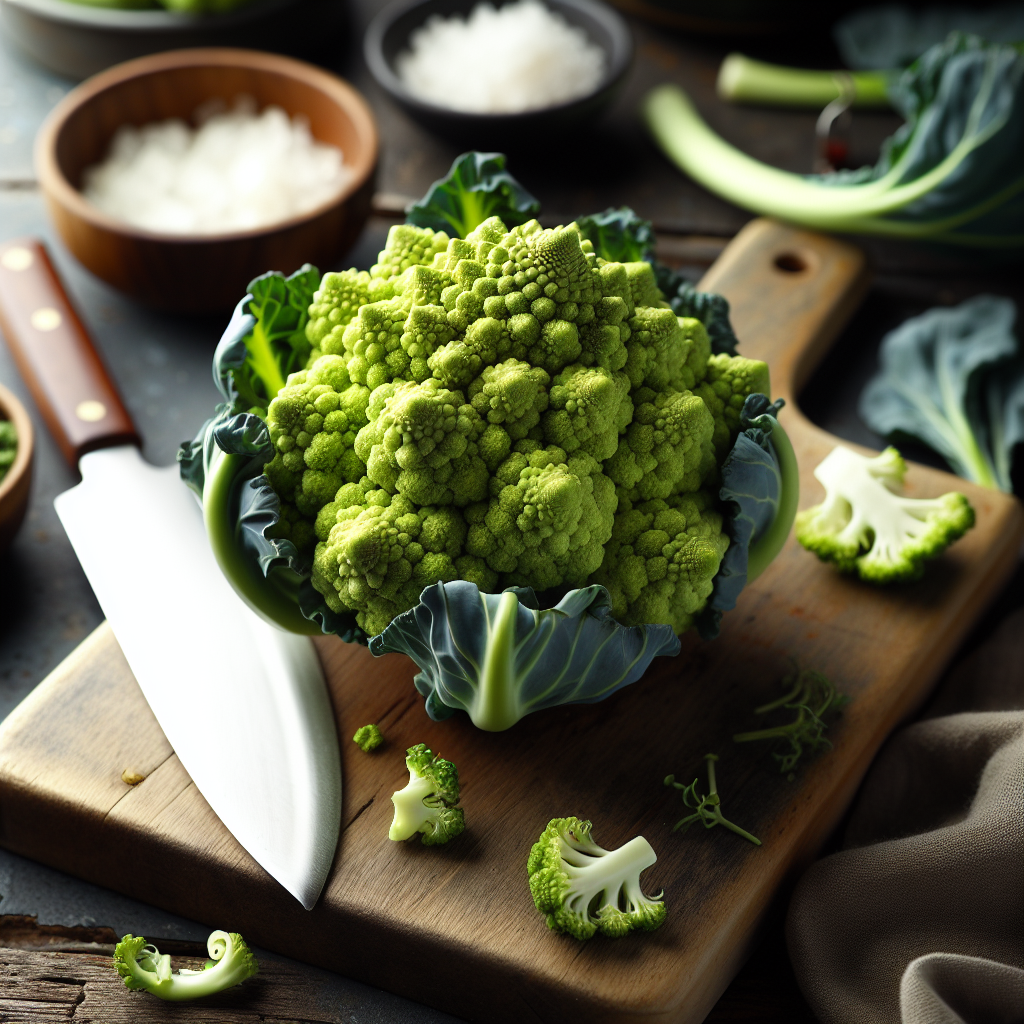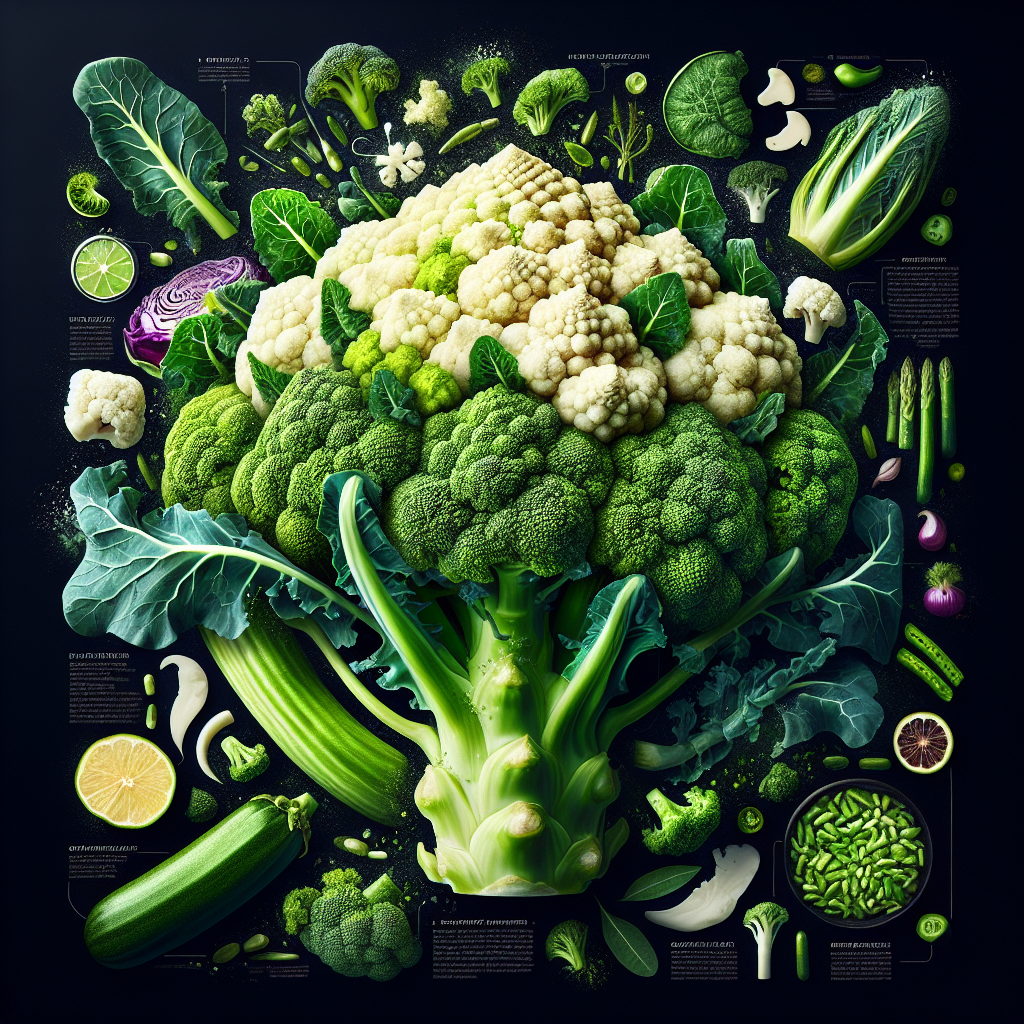You may not have heard of it yet, but there’s a new vegetable in town that’s been making waves – broccoflower. This unique veggie is actually a hybrid of cauliflower and broccoli, combining the best of both worlds. In this article, we will explore the numerous benefits that broccoflower brings to the table, from its rich nutrient content to its versatility in various dishes. Get ready to be pleasantly surprised by the wonders of this delicious and nutritious addition to your meals.

Nutritional Benefits
High in Vitamins
Broccoflower is a nutritional powerhouse, packed with essential vitamins. It is especially rich in vitamins C and K. Vitamin C is a powerful antioxidant that helps boost the immune system and aids in collagen production, promoting healthy skin. Vitamin K is essential for blood clotting and plays a vital role in maintaining bone health.
Rich in Antioxidants
Antioxidants are compounds that help protect our cells from damage caused by free radicals. Broccoflower contains a variety of antioxidants, including beta-carotene and lutein. These antioxidants have been linked to a decreased risk of chronic diseases such as heart disease and certain types of cancer.
Good Source of Fiber
Fiber is an important nutrient that helps regulate digestion and promotes a healthy gut. Broccoflower is an excellent source of dietary fiber, which can aid in digestion and prevent constipation. It also helps you feel fuller for longer, making it a great addition to a weight management diet.
Low in Calories
For those watching their calorie intake, broccoflower is an excellent choice. It is low in calories, making it a great guilt-free addition to any meal. You can enjoy its delicious taste and reap its nutritional benefits without worrying about excessive calorie consumption.
Provides Essential Minerals
In addition to vitamins, broccoflower is also rich in essential minerals. It is a good source of potassium, which helps regulate blood pressure and maintain a healthy heart. It also contains magnesium, which is important for bone health and nerve function. Adding broccoflower to your diet can be a tasty way to ensure you’re getting these vital minerals.
Health Benefits
Cancer Prevention
Broccoflower contains a variety of compounds that have been shown to possess cancer-fighting properties. It is rich in glucosinolates, which are sulfur-containing compounds that have been found to inhibit the growth of cancer cells and prevent tumor formation. Regular consumption of broccoflower may help reduce the risk of certain types of cancer, including breast, prostate, and lung cancer.
Supports Heart Health
Maintaining a healthy heart is crucial for overall well-being, and broccoflower can play a role in promoting heart health. It is rich in antioxidants, including beta-carotene and lutein, which have been linked to a reduced risk of heart disease. Additionally, the fiber content in broccoflower can help lower cholesterol levels and promote a healthy cardiovascular system.
Boosts Immune System
A strong immune system is essential for fighting off infections and diseases. Broccoflower is packed with vitamin C, a powerful antioxidant that boosts the immune system and helps protect against common illnesses like the flu and colds. Adding broccoflower to your diet can provide the support your immune system needs to stay strong and healthy.
Promotes Digestive Health
Maintaining a healthy digestive system is key to overall well-being, and broccoflower can help promote digestive health. The high fiber content in broccoflower aids in digestion and prevents constipation. It also contains a compound called sulforaphane, which has been shown to have anti-inflammatory properties that can benefit the digestive system.
Aids in Weight Management
If you’re looking to manage your weight, broccoflower can be a valuable addition to your diet. Not only is it low in calories, but it is also high in fiber, which helps you feel fuller for longer. This can prevent overeating and aid in weight loss or maintenance. Incorporating broccoflower into your meals can be a delicious and nutritious way to support your weight management goals.

Unique Characteristics
Cross-Breed of Broccoli and Cauliflower
Broccoflower is a unique vegetable, as it is a cross-breed of broccoli and cauliflower. This makes it distinct in appearance and flavor, offering a combination of the best characteristics of both its parent vegetables.
Distinct Appearance
One of the first things you’ll notice about broccoflower is its distinct appearance. It closely resembles cauliflower but has a vibrant green color. Its florets are compact and densely packed, similar to those of cauliflower, but with a slightly different shape.
Milder Flavor
Broccoflower has a milder flavor compared to both broccoli and cauliflower. It has a subtle nutty and slightly sweet taste, which makes it a versatile ingredient in various culinary preparations. Its mild flavor makes it appealing to those who may find the taste of broccoli or cauliflower too strong.
Versatile Usage in Cooking
One of the great advantages of broccoflower is its versatility in cooking. You can use it in a wide variety of culinary preparations, including roasting, steaming, grilling, stir-frying, or adding it raw to salads. Its unique flavor and texture make it a fantastic addition to both vegetarian and non-vegetarian dishes.
Easy to Grow
If you have a green thumb, you’ll be pleased to know that broccoflower is relatively easy to grow. It requires similar growing conditions as its parent vegetables, broccoli and cauliflower. With a little care and attention, you can enjoy the satisfaction of growing your own broccoflower at home.
Broccoflower vs. Broccoli and Cauliflower
Comparing Nutritional Values
When it comes to nutritional values, broccoflower holds its own against its parent vegetables, broccoli and cauliflower. It contains similar levels of essential vitamins and minerals, making it a healthy addition to any diet. However, keep in mind that specific values may vary slightly depending on the variety and growing conditions.
Taste and Texture
While broccoflower shares some flavor and texture characteristics with broccoli and cauliflower, it has its own unique profile. The milder taste and slightly crunchy texture set it apart from its parents. If you enjoy the flavors of broccoli and cauliflower but prefer something slightly different, broccoflower offers an exciting alternative.
Cooking Methods
Broccoli, cauliflower, and broccoflower can all be cooked using similar methods, such as boiling, steaming, roasting, or stir-frying. The cooking time may vary slightly depending on the size and density of the florets. However, broccoflower generally cooks relatively quickly and retains its texture and flavor well.
Availability
While broccoli and cauliflower are widely available in most grocery stores, broccoflower may be slightly more challenging to find. However, its popularity has been increasing, and you can often find it in specialty markets or during its peak harvesting seasons. Additionally, some larger supermarkets may carry broccoflower regularly.

Preparation and Cooking Tips
Selecting Fresh Broccoflower
When selecting broccoflower, look for firm and compact heads with no signs of discoloration. The florets should be tightly packed and have a vibrant green color. Avoid broccoflower with any browning or wilting and opt for ones that feel heavy for their size.
Storing Techniques
To store broccoflower, you can wrap it loosely in a plastic bag to retain moisture and place it in the refrigerator. It will typically stay fresh for up to a week, although its flavor and texture are best when consumed within a few days of purchase. Avoid washing broccoflower before storing it, as excess moisture can cause it to spoil faster.
Cleaning and Trimming
Before cooking broccoflower, give it a thorough rinse under cold water to remove any dirt or debris. Trim off the tough stem and any browned or damaged parts. You can then separate the head into smaller florets for easier cooking and presentation.
Various Cooking Methods
Broccoflower lends itself well to a variety of cooking methods. Here are a few popular ways to prepare broccoflower:
- Roasting: Toss broccoflower florets with olive oil, garlic, and your favorite seasonings. Roast them in the oven until they are tender and slightly caramelized.
- Steaming: Place broccoflower florets in a steamer basket and steam them until they are tender but still slightly crisp. This method preserves their vibrant color and delicate flavor.
- Stir-frying: Heat a pan or wok with some oil and add broccoflower florets along with your choice of vegetables, protein, and seasonings. Stir-fry until the vegetables are cooked to your desired tenderness.
- Boiling: Bring a pot of salted water to a boil and add broccoflower florets. Cook them until they are fork-tender, then drain and serve.
Recipe Ideas
Looking for some delicious broccoflower recipe ideas? Here are a few to get you started:
Roasted Broccoflower with Garlic and Parmesan
Ingredients:
- 1 head of broccoflower, cut into florets
- 2 cloves of garlic, minced
- 2 tablespoons of olive oil
- Salt and pepper to taste
- 1/4 cup of grated Parmesan cheese
Instructions:
- Preheat the oven to 400°F (200°C).
- In a bowl, toss the broccoflower florets with the minced garlic, olive oil, salt, and pepper.
- Spread the seasoned florets out on a baking sheet and roast for about 20 minutes or until they are golden brown and tender.
- Remove from the oven and sprinkle the grated Parmesan cheese over the roasted broccoflower. Serve hot.
Broccoflower Salad with Lemon Vinaigrette
Ingredients:
- 1 head of broccoflower, cut into florets
- 1 cup of cherry tomatoes, halved
- 1/4 cup of sliced red onion
- 1/4 cup of chopped fresh parsley
- 2 tablespoons of olive oil
- Juice of 1 lemon
- Salt and pepper to taste
Instructions:
- Steam the broccoflower florets until they are tender but still slightly crunchy. Let them cool.
- In a large bowl, combine the steamed broccoflower, cherry tomatoes, sliced red onion, and chopped parsley.
- In a separate small bowl, whisk together the olive oil, lemon juice, salt, and pepper to make the vinaigrette.
- Drizzle the lemon vinaigrette over the broccoflower salad and toss to combine. Serve chilled.
Broccoflower Soup with Herbs
Ingredients:
- 1 head of broccoflower, cut into florets
- 1 small onion, chopped
- 2 cloves of garlic, minced
- 3 cups of vegetable or chicken broth
- 1/2 cup of heavy cream
- 2 tablespoons of chopped fresh herbs (such as parsley, thyme, or chives)
- Salt and pepper to taste
Instructions:
- In a large pot, sauté the chopped onion and minced garlic until they are soft and fragrant.
- Add the broccoflower florets and vegetable or chicken broth to the pot. Bring to a boil and simmer until the broccoflower is tender.
- Use an immersion blender or transfer the soup to a blender to puree until smooth.
- Stir in the heavy cream and chopped fresh herbs. Season with salt and pepper to taste.
- Heat the soup on low until warmed through. Serve hot.
Grilled Broccoflower Steaks
Ingredients:
- 1 head of broccoflower, cut into thick slices (steaks)
- 2 tablespoons of olive oil
- 2 cloves of garlic, minced
- Juice of 1 lemon
- Salt and pepper to taste
Instructions:
- Preheat a grill or grill pan to medium-high heat.
- In a bowl, whisk together the olive oil, minced garlic, lemon juice, salt, and pepper.
- Brush the broccoflower steaks with the marinade and let them sit for about 10 minutes.
- Grill the broccoflower steaks for about 3-4 minutes per side or until they are tender and lightly charred.
- Remove from the grill and serve as a delicious, vegetable-centric main dish.
Broccoflower Stir-Fry
Ingredients:
- 1 head of broccoflower, cut into florets
- 1 bell pepper, thinly sliced
- 1 carrot, thinly sliced
- 1 small onion, thinly sliced
- 2 cloves of garlic, minced
- 2 tablespoons of soy sauce
- 1 tablespoon of sesame oil
- 2 tablespoons of vegetable oil
- Salt and pepper to taste
Instructions:
- Heat the vegetable oil in a large skillet or wok over medium heat.
- Add the minced garlic and sliced onion to the skillet, and sauté until they are fragrant and slightly softened.
- Add the broccoflower florets, bell pepper, and carrot to the skillet. Stir-fry for several minutes, until the vegetables are crisp-tender.
- In a small bowl, whisk together the soy sauce, sesame oil, salt, and pepper.
- Pour the sauce over the stir-fried vegetables, and toss until they are evenly coated.
- Continue to cook for another minute or two until the sauce is heated through. Serve hot over rice or noodles.
Broccoflower in a Healthy Diet
Incorporating Into Vegetarian/Vegan Meals
Broccoflower is a fantastic addition to vegetarian and vegan meals, providing a nutritious and flavorful alternative to meat-based dishes. Its versatility allows you to use it in a variety of recipes, such as stir-fries, curries, and roasted vegetable medleys. It can also be added to plant-based grain bowls or used as a substitute for other cruciferous vegetables in vegan versions of traditional recipes.
Broccoflower as a Side Dish
Broccoflower makes a delightful side dish that complements a wide range of main courses. It can be prepared simply by steaming or roasting, allowing its natural flavors to shine. Season it with your favorite herbs and spices, or toss it with some lemon juice and olive oil for a refreshing side dish. Its vibrant color and unique appearance will add visual appeal to any meal.
Broccoflower in Salads
Adding broccoflower to salads can elevate them to a whole new level. Its mild flavor and crisp texture provide a delightful contrast to other salad ingredients. You can slice it thinly and toss it with mixed greens, cherry tomatoes, cucumbers, and your favorite dressing for a fresh and nutritious salad. Alternatively, steam or blanch broccoflower florets briefly before adding them to a grain-based salad for added texture and flavor.
Broccoflower in Stir-Fries
Stir-fries are a quick and easy way to incorporate broccoflower into your meals. Its sturdy florets hold their shape well during cooking and add a pleasant crunch to stir-fried dishes. Combine it with other vegetables, tofu, or your choice of protein, and stir-fry them in a flavorful sauce for a delicious and colorful meal. Serve it over rice or noodles for a complete and satisfying dinner.
Broccoflower in Soups
Broccoflower can lend its unique flavor and texture to a variety of soups. Puree it with other vegetables to create a creamy and nutritious soup, or add it to hearty broths for added substance. Broccoflower pairs well with other vegetables such as carrots, potatoes, or leeks. Its mild taste allows it to blend well with various herbs and spices, making it a versatile ingredient in soups and stews.

Broccoflower and Sustainability
Reduces Environmental Impact
In an era where environmental sustainability is crucial, the cultivation and consumption of broccoflower can have positive effects. Broccoflower requires similar growing conditions as broccoli and cauliflower, and its farming practices align with those of other cruciferous vegetables. By choosing broccoflower, you contribute to reducing the environmental impact associated with monoculture farming and support crop diversity.
Promotes Crop Diversity
Crop diversity is essential for maintaining healthy ecosystems and ensuring food security. By incorporating broccoflower into your meals, you contribute to the promotion of crop diversity. Broccoflower’s unique qualities and characteristics make it an attractive addition to a diverse range of crops, allowing farmers to grow and cultivate a wider selection of vegetables.
Supports Local Agriculture
Choosing to consume broccoflower supports local agriculture and small-scale farmers. This decision reduces the carbon footprint associated with long-distance transportation and promotes local economies. By purchasing broccoflower from local farmers, you contribute to the vitality and sustainability of your community while enjoying a nutritious and delicious vegetable.
Less Food Waste
Broccoflower is less susceptible to food waste compared to other vegetables. Its compact florets and sturdy structure allow it to stay fresh in the refrigerator for longer periods. By storing broccoflower properly and utilizing all parts of the vegetable, you can significantly reduce food waste in your kitchen. This is not only beneficial for the environment but also helps you save money and make the most of your ingredients.
Broccoflower Varieties and Availability
Popular Broccoflower Varieties
While the original broccoflower is green, there are now various cultivated varieties available. Purple broccoflower is one of the most popular variations, with a vibrant purple color. It offers the same nutritional benefits as its green counterpart and can add a unique visual element to your meals. Other varieties, such as Romanesco broccoflower, have distinctive fractal patterns and slightly different flavors.
Seasonal Availability
Broccoflower is typically in season from late fall to early spring, although availability may vary depending on your location. During its peak season, you are more likely to find a wide range of broccoflower varieties in stores and farmers’ markets. Off-season, you may need to look for frozen or preserved broccoflower products.
Finding Broccoflower in Stores
While broccoflower may not be as widely available as traditional broccoli or cauliflower, its popularity has been steadily increasing. You can often find broccoflower in specialty grocery stores or larger supermarkets that carry a wide selection of produce. If you can’t find it locally, consider reaching out to local farmers or exploring online grocery retailers that offer a broader range of fresh vegetables.
Growing Broccoflower at Home
If you have a vegetable garden or enjoy growing your own produce, broccoflower can be a rewarding addition to your homegrown selection. It is relatively easy to grow, requiring similar conditions to broccoli and cauliflower. Start seeds indoors in late winter or early spring and transplant them to your garden when the weather is suitable. With proper care and attention, you can enjoy the satisfaction of growing your own broccoflower at home.

Conclusion
Broccoflower, the cross-breed of broccoli and cauliflower, offers a myriad of health benefits and unique characteristics that make it a fantastic addition to any diet. Its high vitamin content, rich antioxidants, and fiber make it a nutritional powerhouse. Broccoflower’s potential health benefits include cancer prevention, heart health support, immune system boosting, digestive health promotion, and weight management aid.
The unique characteristics of broccoflower, such as its distinct appearance, milder flavor, and versatile usage in cooking, set it apart from its parent vegetables. Whether you’re enjoying it in a freshly prepared salad, as a flavorful side dish, or as the star ingredient in a stir-fry, broccoflower adds variety and excitement to your meals.
When comparing broccoflower to broccoli and cauliflower, it holds its own in terms of nutrition and taste. The availability of broccoflower may vary, but its popularity has been growing, making it more accessible in stores, especially during its peak season.
To enjoy broccoflower at its best, practice proper selection, storage, and cooking techniques. Try out the various cooking methods and experiment with delicious recipes like roasted broccoflower with garlic and parmesan, broccoflower salad with lemon vinaigrette, or broccoflower soup with herbs.
Incorporating broccoflower into a healthy diet offers numerous benefits. Whether you’re a vegetarian or vegan looking for nutritious alternatives, seeking a versatile side dish, or aiming to add variety to your salads, stir-fries, and soups, broccoflower fits the bill.
Moreover, consuming broccoflower promotes sustainability by reducing environmental impact, supporting local agriculture, and minimizing food waste.
With its unique varieties, availability, and the possibility of growing it at home, broccoflower provides endless opportunities to add flavor, nutrition, and beauty to your meals. So why not give broccoflower a try and explore the exciting world of this delicious hybrid vegetable?

